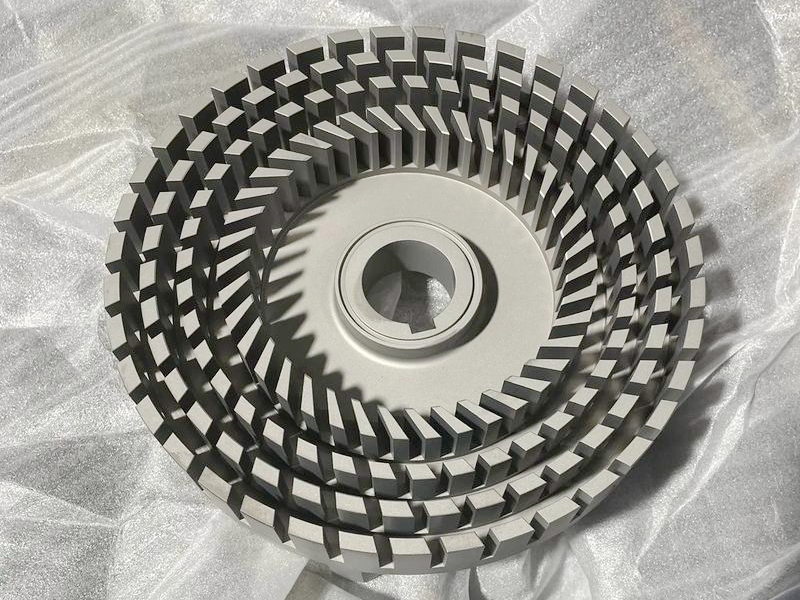Nitriding: The Secret to Harder, More Wear-Resistant CNC Machining Components
Introduction
Nitriding is a thermochemical surface treatment that significantly improves the hardness, wear resistance, and fatigue life of CNC machined components, especially those made from alloy steels, tool steels, and stainless steels. By diffusing nitrogen atoms into the metal surface at 500–580°C, a hardened layer (known as the compound or “white” layer) forms without altering the core properties or dimensions of the part.
Highly valued in aerospace, automotive, power generation, and tooling applications, nitriding is ideal for complex CNC machined parts such as shafts, gears, spindles, and valves where precision, surface hardness, and dimensional stability under stress are essential.
Nitriding Technology: Enhancing Surface Hardness Without Compromising Precision
Scientific Principles & Industrial Standards
Definition: Nitriding is a diffusion-based heat treatment where nitrogen is introduced to a ferrous alloy surface in a controlled environment, forming hard nitrides that increase surface hardness and resistance to wear, fatigue, and corrosion.
Governing Standards:
AMS 2759/6: Nitriding of steel parts
ASTM F2328: Nitriding process qualification
ISO 17438-1: Surface hardening using gas nitriding
Process Function and Cases
Performance Dimension | Technical Parameters | Application Cases |
|---|---|---|
Surface Hardness | - HV: 900–1,200 (compound layer) - Case depth: 0.1–0.7 mm | Gear wheels, Mold cores, Aerospace shafts |
Wear Resistance | - Wear rate reduction: up to 80% - Microstructure: ε-Fe₂₋₃N and γ’-Fe₄N formation | Automotive camshafts, Hydraulic cylinder rods, Linear motion guides |
Fatigue Strength | - Fatigue life improvement: 30–60% - Residual compressive stresses on surface | Powertrain components, Engine crankshafts, Spindles |
Dimensional Stability | - Low process temperature (≤580°C) - Near-zero distortion | Precision threads, Thin-walled housings, High-tolerance assemblies |
Nitriding Process Classification
Technical Specification Matrix
Nitriding Type | Key Parameters & Metrics | Advantages | Limitations |
|---|---|---|---|
Gas Nitriding | - Temp: 500–570°C - Duration: 10–100 hrs - Atmosphere: Ammonia (NH₃) | - Excellent control over case depth - Uniform treatment of complex parts | - Long cycle times |
Plasma (Ion) Nitriding | - Temp: 450–580°C - Low pressure plasma environment | - Precise control, minimal distortion - Eco-friendly and faster cycle | - Higher equipment costs |
Salt Bath Nitriding | - Temp: 525–575°C - Molten cyanate bath | - Rapid nitrogen diffusion - Shorter cycle times | - Toxic byproducts and strict environmental controls |
Ferritic Nitrocarburizing (FNC) | - Temp: 560–580°C - Addition of carbon species | - Enhanced wear and corrosion resistance - Low friction surface | - Lower achievable hardness than pure nitriding |
Selection Criteria & Optimization Guidelines
Gas Nitriding
Selection Criteria: Best suited for large-volume CNC parts requiring uniform case depth and enhanced fatigue performance with minimal dimensional change.
Optimization Guidelines:
Use alloy steels with nitride-forming elements (Cr, Mo, V)
Optimize ammonia flow and cycle duration for desired depth
Monitor surface hardness and depth using microhardness testing
Plasma (Ion) Nitriding
Selection Criteria: Ideal for high-precision CNC parts with tight tolerances and intricate geometries requiring minimal distortion and clean processing.
Optimization Guidelines:
Pre-clean parts thoroughly to ensure plasma uniformity
Adjust bias voltage and gas ratios for target hardness profile
Apply pulse plasma cycles to reduce thermal stress
Salt Bath Nitriding
Selection Criteria: Effective for small and medium CNC parts needing high wear resistance and fast turnaround in toolmaking and industrial machinery.
Optimization Guidelines:
Control bath chemistry for nitrogen release efficiency
Use proper neutralization systems to meet environmental regulations
Perform post-treatment quenching and tempering if needed
Ferritic Nitrocarburizing (FNC)
Selection Criteria: Recommended for automotive and general machinery CNC parts requiring improved wear and corrosion resistance at a competitive cost.
Optimization Guidelines:
Incorporate carbon-carrying gases (CO, CO₂) in the atmosphere
Polish surface before FNC for best tribological results
Combine with post-oxidation for added corrosion protection
Material-Coating Compatibility Chart
Substrate | Recommended Nitriding Type | Performance Gain | Industrial Validation Data |
|---|---|---|---|
Gas Nitriding | Hardness: up to HV 1,100 | Gear shafts validated for 60% longer fatigue life | |
Plasma Nitriding | Minimal distortion with superior wear resistance | Injection mold cores certified for 3× tool life | |
Salt Bath Nitriding | Enhanced abrasion resistance | Valve components tested for 80% wear reduction | |
Plasma Nitriding | Improved surface hardness (up to HV 900) | Aerospace brackets validated for anti-galling performance | |
Ferritic Nitrocarburizing | Balanced wear and corrosion protection | Automotive cam components passed 240 hr salt spray test |
Nitriding Process Control: Critical Steps & Standards
Pre-Treatment Essentials
Surface Cleaning: Alkaline ultrasonic or plasma pre-cleaning Validation: ASTM F22 water-break test
Surface Roughness Prep: Ra < 0.8 µm for uniform case depth Validation: Profilometer analysis
Nitriding Process Controls
Temperature Control: ±5°C accuracy using thermocouples Validation: Real-time cycle monitoring
Atmosphere Composition: Controlled nitrogen potential (KN value) Validation: Gas composition analysis (mass spectrometry or sensors)
Post-Coating Enhancement
Compound Layer Inspection: Etch testing to assess phase structure Validation: Metallographic analysis per ASTM E3
Hardness Testing: Microhardness depth profiling Validation: ASTM E384 hardness measurement
FAQs
What materials are best suited for nitriding in CNC applications?
Does nitriding affect the dimensions of CNC precision parts?
How does nitriding compare to case hardening or carburizing?
Can nitrided parts be further machined or ground?
Is nitriding effective for stainless steel or titanium components?

